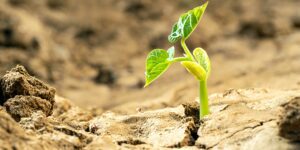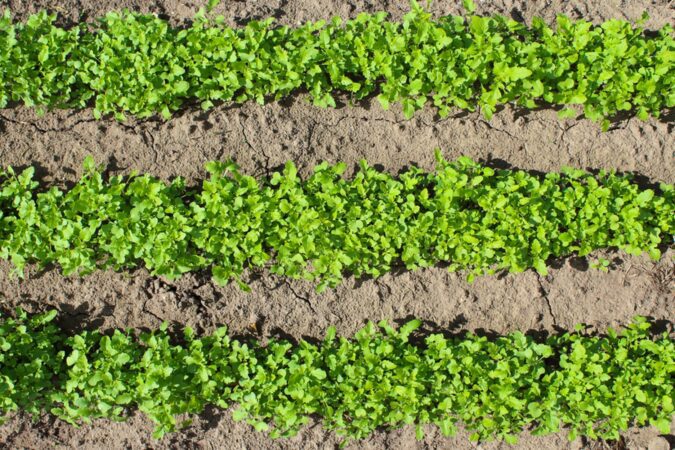
Watering plants is important for their growth and to produce a great harvest. But if you reside in a dry and hot area, planting drought-tolerant crops is a good idea.
Drought-resistant crops that don’t need much water grow even in dry conditions. For example, veggies like asparagus and rhubarbs grow in arid environments.
Planting drought-tolerant crops is a great strategy for those living in low-rainfall regions. To know how to grow and maintain a water-conscious garden, read the below post:

Source: https://modernfarmer.com/wp-content/uploads/2022/06/shutterstock_1956949345.jpg
Drought-Tolerant Vegetables To Grow
Here’s the list of crops that don’t need much water to grow:
Rhubarb
Rhubarb plant doesn’t need a lot of water, once it is settled. When planting it for the first time, it needs regular watering for its crown and roots to develop, but after a while, it manages with minimum water, especially during dry times.
Rhubarb has big roots that survive without much water, so once it’s all setup, you don’t have to water it much.
Asparagus
Asparagus is a fancy plant liked by people for its taste but it takes a while to grow. The spears appear about three years from the time you put the asparagus in the ground.
When still young, asparagus needs regular watering to grow. Once it matures, it can go without much water and handle dry and hot weather well. Unless there is a long dry period, you don’t need to water it much after it’s all grown up.
Corn
Corn plants have long and fibrous roots that go searching for water below the ground, helping it to withstand drought seasons. When there’s less water, it rolls its leaves to reduce water loss through evaporation. It needs watering the most when the cobs start swelling.
Growing corn lets you enjoy homegrown cobs during the summer months. A cob is ready for harvest when its end tassels turn brown. To confirm, you can poke a kernel and see if it releases a creamy liquid.
Pole Beans
Pole beans are crops that don’t need much water and are grown vertically on structures. They can handle drought and yield a larger harvest even with less water.
Pole beans have longer roots than other crops and can search for water deep in the soil. There are specific varieties of pole beans, like Rattlesnake, that are particularly tough in dry conditions.
Pole beans are also known as runner beans or green beans. Another type that can grow with less water is French beans.
Squash
Squash plants require plenty of nutrients to grow, but once they are settled, they can handle drought well. They flourish in nutrient-rich solid and sunny spots, which are essential for their growth and health. In the early stages, they require regular watering and plenty of space to spread out.
When matured, squash plants become more resilient to drought. Their leaves may wilt when water is scarce, but they recover quickly. The leaves shade the ground to reduce water loss, a characteristic shared by pumpkin plants.
There are different varieties of squash plants, including both winter and summer types that tolerate drought. They make an excellent choice for a water-efficient garden.
Chilli Pepper
Chilli peppers are well-suited for dry and hot climates as they endure better in these conditions. It makes them spicier, which is a defense mechanism used by the plants against drought and excessive sunlight.
There is a wide variety of chili peppers to choose from, each offering a diverse range of shapes, flavors, and colors. Chilli peppers require adequate water for establishment, but once they are settled, they can be managed with minimum water.
Water scarcity for a longer period can, however, impact their yield. Chili peppers, including bell peppers, are associated with greenhouse cultivation, but they can also flourish outdoors, provided the summers are warm.
Zucchini
Zucchini plants thrive when they possess deep root systems as they help to seek moisture during times of drought. These plants benefit from their broad foliage, which shades the soil, minimizing water loss during the day.
Dark Star zucchini is commonly grown in California and is popular for its ability to withstand drought.
Zucchini plants require ample water during the initial planting phase, but once they establish a root system, it can be managed in dry conditions.
Tips To Grow Drought-Tolerant Crops
Here are some tips to grow drought-tolerant crops and vegetables:

Source: https://agriculture.borax.com/USBorax/media/assets/images/blog/drought-695×350.jpg?ext=.jpg
Improve Soil Quality
Enhance the soil’s moisture retention capacity by using plenty of compost during the planting phase, especially around the plants. When pure sand is present, rainwater can easily pass through at a rate of up to 20 inches per hour and carry away the nutrients required by plants. Soil enriched with organic matter slows down the drainage, helping plants to absorb the vital elements they need.
Keep Your Garden Small
When growing a food garden, assess the plants you want to grow and avoid exceeding your requirements. For a small food garden, a few hills of cucumbers or zucchini is enough for four people.
Plant Closely
Choose crops that grow closer to the soil as they tend to lose less water through transpiration. Find out the drought-resistant seed varieties that require minimal space. Planting them close together will keep them shaded by the leaves of neighboring plants and help in moisture retention.
Mulch Nicely
Mulching the soil nicely prevents moisture from evaporating and controls weed growth. When the soil is moist, apply organic mulch such as shredded leaves, or bark around the plants. You can also use other items like flat stones, old carpet, plastic, or newspaper.
Reduce Evaporation
The best time to irrigate a garden is early in the morning or evening. These are the times when the least amount of water evaporates from the soil and leaves.
For root development, saturate the garden thoroughly. Deep watering is the best method as it helps roots to extend deeper into the soil and search for moisture.
Final Words
Crops that don’t need much water to grow are ideal for dry and hot areas. These vegetables are a great choice for those wanting to grow a water-conscious garden. By following the tips in this post, it becomes easier to grow drought-tolerant crops.
